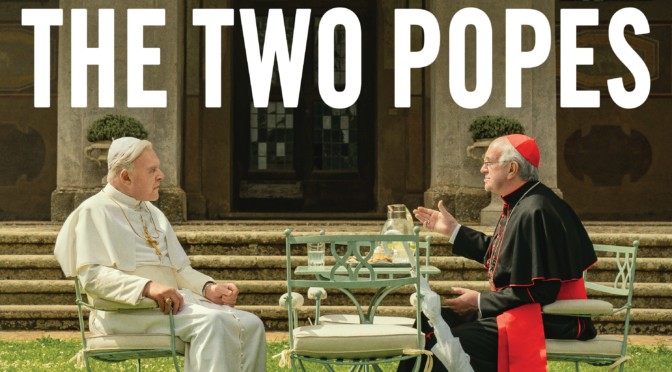At his summer residence in the Palace of Castel Gandolfo, Pope Benedict XVI (Anthony Hopkins; The Silence of the Lambs), previously known Joseph Ratzinger before his papacy, and Cardinal Jorge Bergoglio (Jonathan Pryce; Brazil) discuss the future of the Catholic church and, most importantly, each other.
For a movie that is mostly old men talking, The Two Popes can be remarkably engaging. The initial meeting of Ratzinger and Bergoglio is an extended repartee where neither appears to be on the same wavelength. Bergoglio is trying to get the Pope’s signature to allow his retirement, but Ratzinger seems intent on changing the topic. Instead he grills Bergoglio on his positions and past actions, pressing on his reasoning and how it compares to the Catholic church’s official stances. These are the film’s strongest sections because the writing allows each person to be seen as a flawed individual, rather than being limited to their position.
The more they interact, the more the actors are able to add to their personalities. Both Hopkins and Pryce are seasoned professionals and while neither is able to fully hide that they are English rather than German or Argentinian, they easily bring out the unique traits of the two men. Pryce makes Bergoglio an impassioned but humble humanitarian who cares more about helping others than upholding dogma. Hopkins shows Ratzinger to be ambitious, but practical. While he wants to keep his position, he is more interested in the continuation and growth of the church and is willing to make personal sacrifices for its sake. Both are more than their titles indicate and the script gives them each personality quirks like favorite hobbies or television shows that add some levity to their characterizations. The roles are rich opportunities for the leads to make the holy leaders human and relatable.

Director Fernando Meirelles (City of God) opts to shoot The Two Popes in a documentary style. As the men converse, Meirelles uses handheld cameras that follow the leads as if trailing a live event. There are zooms, wide shots around corners, and scenes where the camera appears to be behind a bush following the conversation. The visuals are similar to the fly-on-the-wall style in Armando Iannucci’s work (Veep), but without the farce. This creative choice prevents the film from feeling like prestige Oscar-bait and instead makes it a more humble and honest affair.
While the film does portray its subjects positively, it doesn’t make them saints. They are shown having doubts and regrets about themselves and their past actions. They even address major issues like the church’s knowledge and concealment of sexual abuse and the responsibility they have to the victims and their other followers. Several of these scenes involve flashbacks with other actors playing younger versions of the leads but these are the least compelling sections, despite providing additional background on how the men became who they are today. They also occupy a significant portion of the film’s runtime and carry nowhere near the heart and humor of the simple discussions. The significant use of flashbacks undermine the chemistry of the two fantastic leads, but The Two Popes is still a lively, welcome surprise.

3/5 stars.
